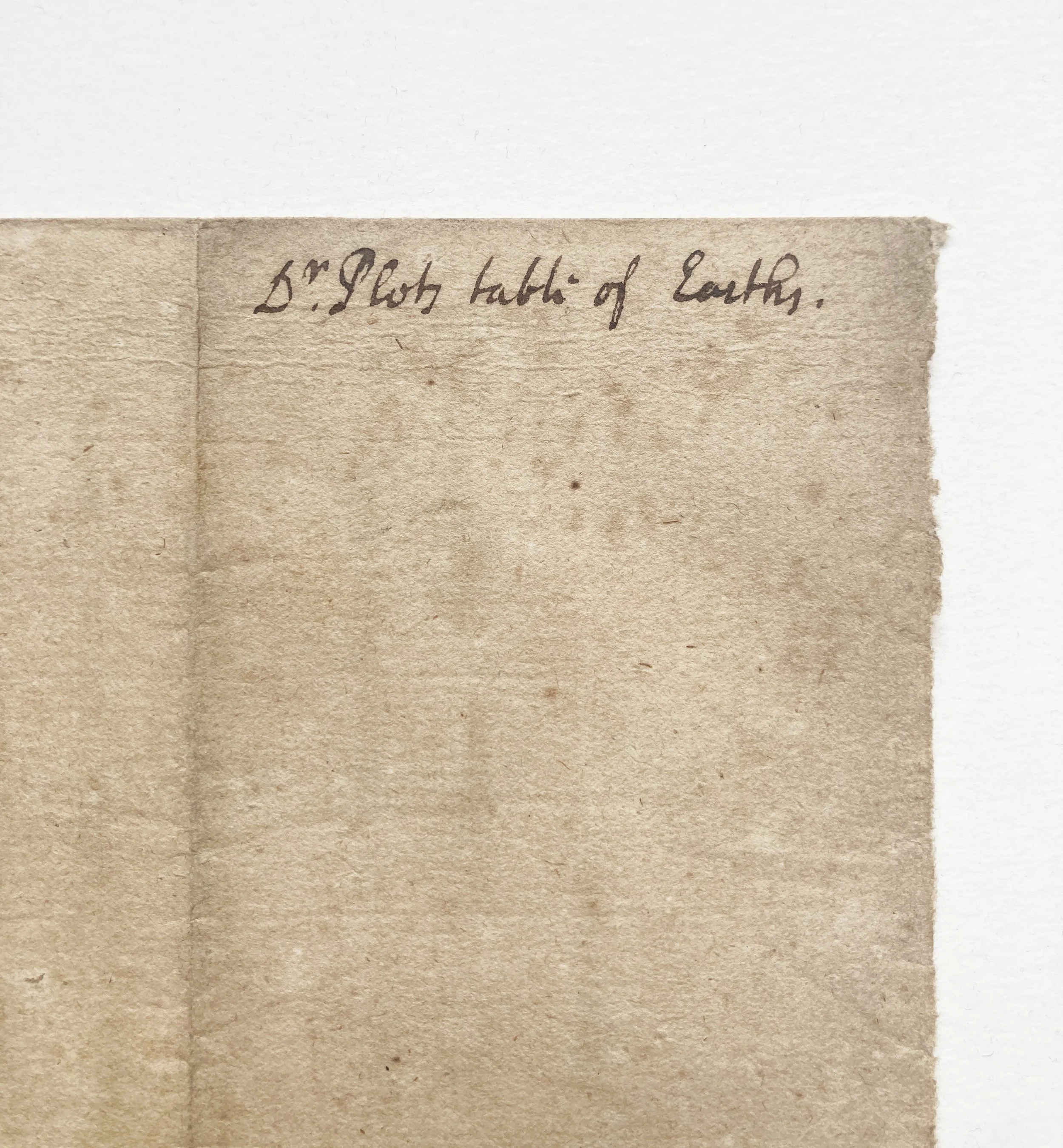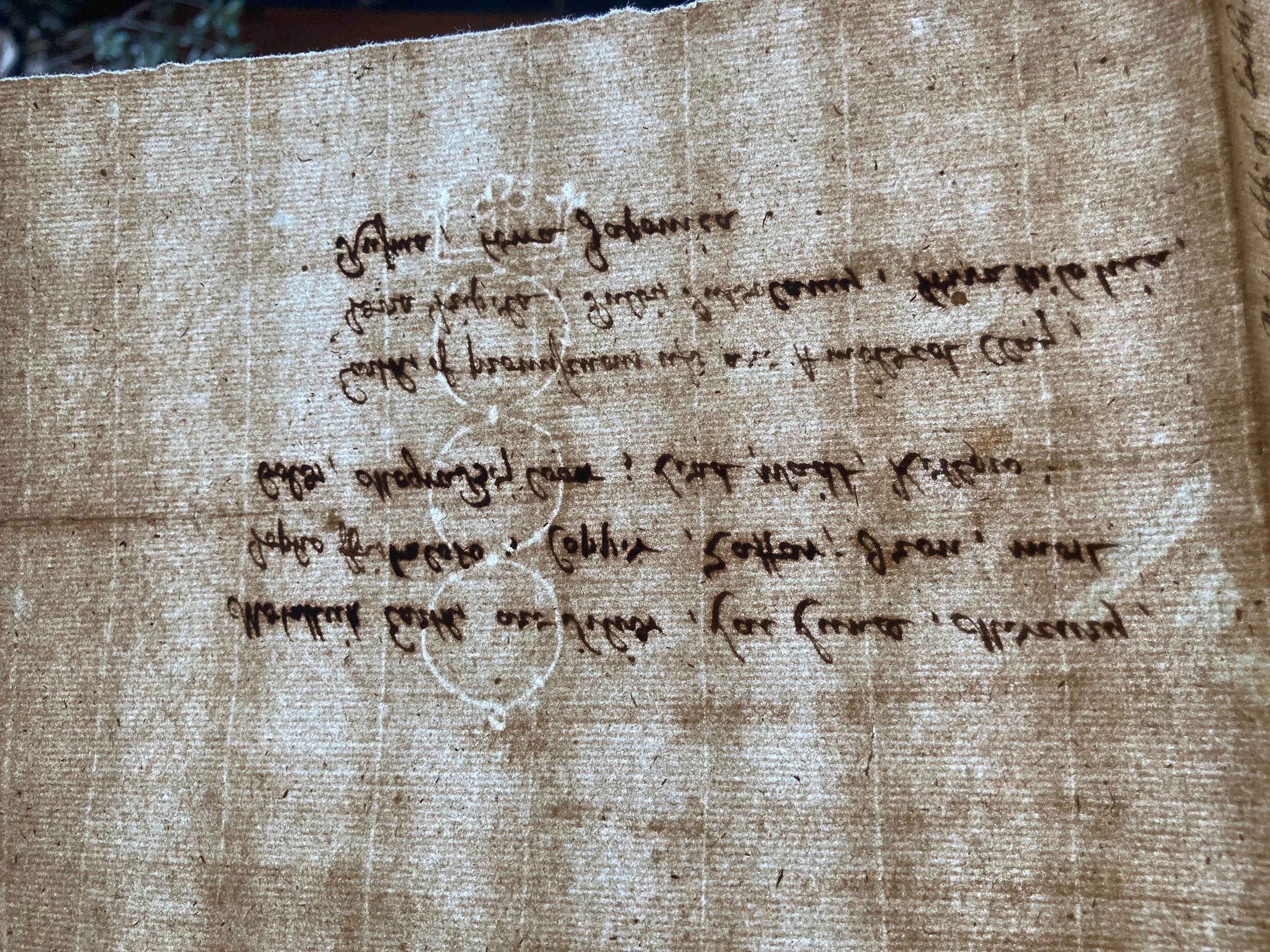Plot's mineralogical lecture, 1683: a founding document of Oxford science



Plot's mineralogical lecture, 1683: a founding document of Oxford science
PLOT, Robert (bap. 1640, d. 1696)
Manuscript with the docket title ‘Dr. Plots table of Earths’, [Oxford, October-November 1683]
Single sheet, folded once, with older flattened folds; slightly irregular but 220 x 382 at its tallest; laid paper with three circles and crown watermark; very good condition
Essay
The manuscript of Robert Plot’s ‘Discourse on Earths’, delivered at the first scientific meeting at the original Ashmolean Museum, October 26th, 1683, and a foundational work in the history of mineralogy. A document witness to the birth of institutional science at Oxford, and also a decisive moment in the history of earth science.
Plot’s lecture effectively inaugurated the Ashmolean, as he was the Museum’s first Keeper, and the October 26th meeting was the first at the Ashmolean of the long established Philosophical Society of Oxford. The building had been opened in May 1683 to house the collections of Elias Ashmole and others, and featured a large lecture room, with a well-lit museum on the floor above, and a physically separate basement laboratory, overseen by Christopher White. Plot’s mineralogical lecture was therefore an apt beginning, as it united the three functions of the Ashmolean: it was a learned analytical discourse, which made use of the collections, and included results of experiments carried out on a wide range of ‘earths’.
The lecture also continued the close relationship between the Oxford Philosophical Society and the Royal Society of London. The Philosophical Society in fact preceded the Royal Society by around a decade, and many members of the former also became fellows of the latter, Plot included. The day after Plot’s lecture members of the Royal Society were informed of it, and the suggestion was made that ‘when perfected, [the Discourse] would make a table of all kinds of earths, such as the Society had desired of [Plot] at his being in London.’ This makes clear that Plot had been instructed not only to give a lecture on mineralogy, but also to arrange his findings into a tabular format. Until now we only knew of the lecture itself, which was recorded in the Minutes of the Philosophical Society. The present manuscript is arranged in tabular format and therefore constitutes the sole survival of Plot’s intended format.
The manuscript was almost certainly drawn up either by Plot himself, his secretary, or another member of the Philosophical Society, for communication to the Royal Society – though it evidently never completed its journey to London. The paper, script and provenance (see below) all indicate composition contemporary with or prior to the lecture itself.
Robert Plot studied at Magdalen Hall, Oxford, and in 1683 became both the University’s first Professor of Chemistry, and also the first Keeper of the Ashmolean Museum, which was opened in May of that year. Plot was a polymath, with a particular expertise in earth sciences considered broadly, including land survey, mineralogy, archaeology and chemistry. In the 1660s he joined the circle of savants around Robert Boyle and Thomas Willis, and around that time planned a Baconian survey of the whole of Britain. From Camden, Leland, and drawing more deeply on Pliny, Plot was committed to the tradition of ‘chorography’ – close regional and antiquarian descriptive science – and to this end he completed his pioneering Natural History of Oxford-shire, being an Essay toward the Natural History of England, published by Oxford University Press in 1676. This led to his appointment as Fellow (1677) and then Secretary (1682–4) of the still young Royal Society.
The Oxford Philosophical Society, meanwhile, has its origins in the informal ‘experimental philosophicall clubbe’, formed around the year 1651 and led by John Wilkins. Early members included Seth Ward, William Petty, Robert Boyle, John Wallis and many others; the group met at various locations until the construction of the Ashmolean gave it a permanent home. The Society is rightly seen as an immediate precursor of and inspiration for the Royal Society (founded 1660). The relationship between the two societies remained deeply important for both, as evidenced by Plot’s multiple roles circa 1683, and the idea that the present manuscript would be a contribution to the Royal Society’s burgeoning interest in mineralogy.
Plot’s contributions to this area of study are profound: in The Natural History of Oxford-shire, he catalogued minerals, fossils, and other natural objects found in the region. In his subsequent Natural History of Stafford-shire (1686) he brought deeper analytical rigour to his studies, evidently drawing on the approach first recorded in his 1683 lecture. In spite of its very early date, Plot’s researches in this area are little studied – perhaps owing to their presentation in apparently regional-antiquarian publications, and also the failure to publish the present manuscript. Moreover, the lecture as transcribed in the Minutes of the Oxford Philosophical Society is hard to interpret, whereas the division and sub-division of earths is easily comprehensible in tabular form. Compare, for example, the Minutes:
He divides Earths into barren, and fruitfull; 1 the barren are void of salts; and are either, 1 loose, and friable, as Sandy, and gravelly Earths ; 2ly tenacious, not ductile; but chopping in ye fire, as all stiff clays
With the same as laid out in the manuscript (see photographs).
Before Plot, experimental studies of minerals had tended to be either strictly utilitarian, as in metallurgy and pharmacology, or focused on chemical composition, as in the work of Robert Boyle. Earlier classificatory schemes – for example that of Ulisse Aldrovandi (1522–1605) – were not based on experimental analysis. The present manuscript is therefore one of the earliest texts (if not the earliest) to bring the experimental method to bear on the classification of minerals, an approach made fully systematic more than a century later, in the work of Jöns Jacob Berzelius (1779–1848).
Provenance
Macclesfield Library, found within the Macclesfield copy of John Wilkins’ Essay Towards a Real Character, and a Philosophical Language, and hence never incorporated into the illustrious Macclesfield Papers. For the sale of the Wilkins see Forum Auctions, Books from the Macclesfield Library, Thursday 3rd July 2025, Lot 113
References
R.T. Gunther, Early science in Oxford, Vol. IV: The Philosophical Society (Oxford University Press, 1925)
W. Campbell Smith, ‘Early mineralogy in Great Britain and Ireland’, Bulletin of the British Museum (Natural History) Historical Series Vol. 6, No. 3 (1978), pp. 49–74
Anthony J. Turner, ‘Plot, Robert (bap. 1640, d. 1696)’, Oxford Dictionary of National Biography
Anthony J. Turner, Seeking Natural Knowledge in Later 17th Century England: Robert Plot, the Ashmolean Museum, and the Oxford Philosophical Society (Oxford University Press, 2025)

